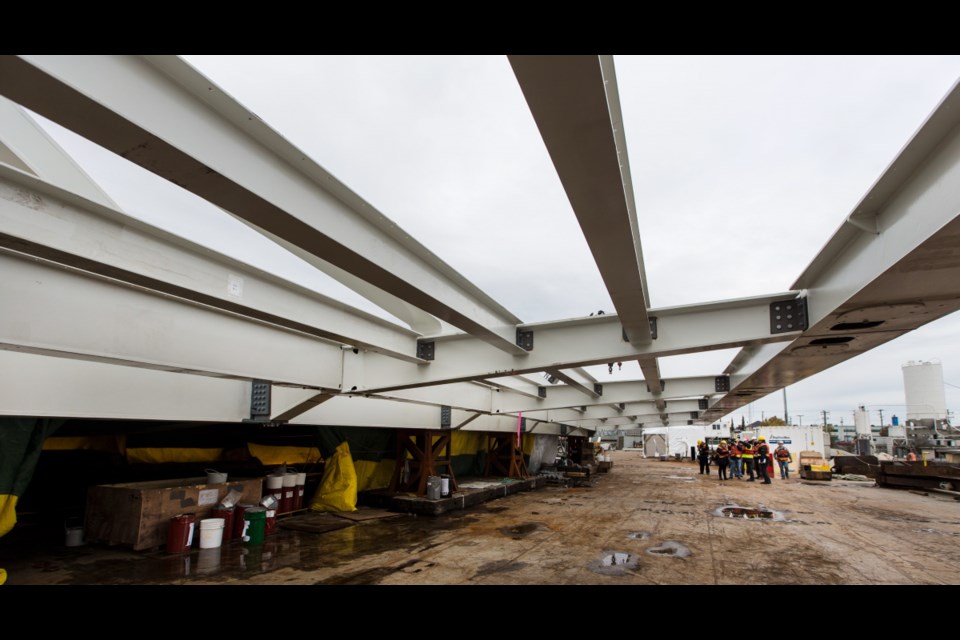The jigsaw puzzle that is the new Johnson Street Bridge is steadily coming together, with officials standing firm that it will be ready for traffic by the end of March.
Fitting all of the steel components into a finished product has its complexities, said Jonathan Huggett, the city’s project director.
“I’ve joked about this in the past,” he said. “We’re building a Swiss watch, not a bridge.”
Anyone travelling over the current Johnson Street Bridge could take a glance at the site of new bridge and assume not much is happening.
But while the site itself sometimes has no workers, up to 30 are on the job every day a short distance away. Crews are spread along the Harbour Road industrial area as well as on a nearby barge, where the bridge’s main span, and walking and cycling areas are taking shape.
The north side of the bridge will feature a five-metre-wide pedestrian-and-cycling route — known as the MUD, or multi-use deck — while the south will have a narrower component for pedestrians only. Both are well underway, and will soon have their aluminum surface planking installed.
Cyclists will also be able to use the main part of the bridge, Huggett said.
“On the main span, on the road deck, they’re in the process of adding the road surfacing for both the vehicle traffic and also for the cyclist lanes that are also on the bridge,” he said. “So there are all kinds of options for cyclists, all kinds of options for pedestrians, and then three lanes of vehicle traffic on the bridge.”
A media tour Wednesday highlighted massive parts such as the bridge’s two 290-ton rings vital to the process of raising and lowering the structure. The rings, 15 metres in diameter, are scheduled to be lifted into place over five days starting Nov. 30.
“At that time there’ll be a five-day marine-channel closure,” Huggett said.
“There will be intermittent one-hour closures of the roadway when some of the big structures are in the air, to protect the public.”
He said the rings will be moved by a large crane known as the Dynamic Beast, based on a barge about 100 metres long and about 36 metres wide.
“Toward the end of January, the crane will return.”
That is when the main span will be moved to its permanent spot, allowing for installation of the bulk of the bridge.
“And then all that remains is really to finish off some of the detail, but more importantly to test it and make sure it works as intended, do a safety audit, make sure it is safe for public use.”
No sooner will the new bridge be ready for traffic than demolition will start on the old bridge, Huggett said. It will be a two- to three-month job.
The position of the old bridge means that the southern pedestrian walkway on the new bridge won’t be open until after demolition is complete, Huggett said.
“That involves taking out the steel structure but also digging out the big concrete abutments on each side and creating some of the public realm that we’ve been talking about, where the public spaces will be created.”
No decision has been made on how extensive the public area will be, he said.
The city is happy with the progress being made and with the opportunities for local employment, Huggett said.
Major steel components for the bridge, such as the main span and the rings, were made in China, and problems with the quality of the work last year has delayed completion of the project. The final steel components arrived in Victoria this fall.
“The city’s really pleased with the quality and skill of some of the local workers that have been used on this project, to finish it off,” Huggett said.
That includes local painters and United Engineering, which has taken on difficult engineering tasks such as attaching the bridge machinery to the rings, he said.
“It’s really been a big local effort to push to get this project to completion.”
He acknowledged that there have been “challenges” along the way, but said that is typical of any such project.
“There are no major challenges at the moment.”
The cost of a bridge to replace the current Johnson Street Bridge was estimated at $63 million in 2009, then climbed to $92.8 million in 2012 when the contract for a new span went to PCL Constructors Westcoast. The cost is now at $105 million.



